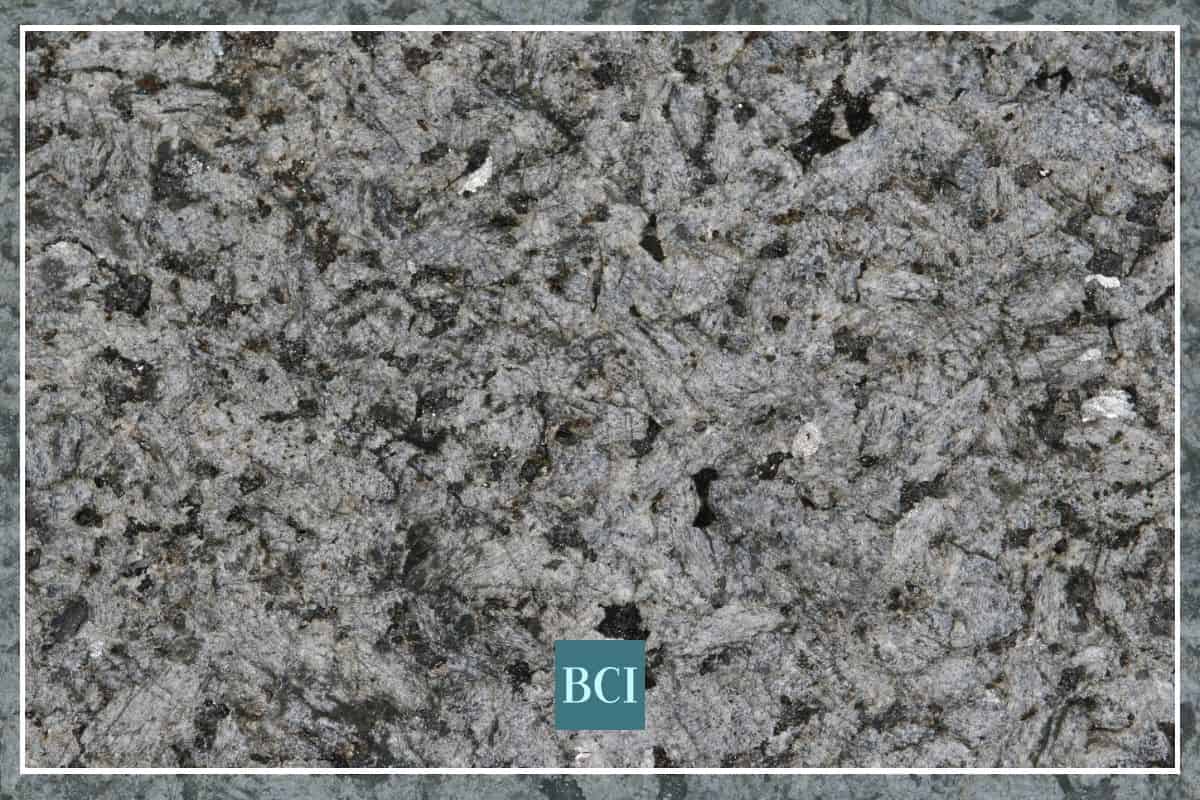Granite countertops are an excellent choice for the home. Here’s our quick guide to get you up to speed on this classic material.

The Basics of Granite Countertops
Unlike other stone countertop materials, such as quartzite, marble, and soapstone, granite is an igneous rock. In other words, it’s cooled liquid magma. (Anyone else say “magma” like Dr. Evil? Just me?) The minerals quartz, mica, and feldspar give granite its quintessential look of coarse grains and flecks of color.
Granite’s geological composition makes it one of the most durable countertop options. Although granite is porous, an applied sealer reduces the absorption of liquids. Some types of granite are more dense and less porous, but they all need to be sealed. A sealer should be applied periodically to granite to protect it.
When most people think of granite, they picture a fleck-y surface with lots of contrast between the flecks and background. These counters have an overall busy look. In this case, the granite has been rift cut, or cut from the top of the stone. A recent trend is to use vein cut granite (cut from the side), which produces lovely veining similar to marble. It’s amazing to see how you can get two vastly different looking slabs, depending on the direction of the cut.
Designing with Granite Countertops
As a natural stone, every granite slab will look slightly different. So, it’s best to visit a stone yard and select the individual slabs for your project. It’s also a good idea to pick sequential slabs from the same bundle so that your counters will have similar colors and veining.
Granite comes in an approximately 5.5’x10′ slab. A kitchen project will probably need 2-4 slabs. The actual number will depend on the kitchen size and if there is an island.
The countertop fabricator will use a template to determine the number and optimal use of the individual slabs for a project. They will also place the countertop layout over an image of the slab. The layout can be moved around to minimize undesirable features, like an area of discoloration, in the slab. This layout will include seam locations, seam directions, and how the slabs will look.
At this point, the fabricator usually requires the owner to review and sign off on the layout. Be sure to give the layout the attention it needs! Check that seam locations are acceptable, and that the veining and color on the slabs are consistent. The countertops should look like one seamless material. Keep in mind, though, that it may not be possible to get it perfect.
Granite is perfect for use in the kitchen. It’s durability combined with great looks, make it a go-to material. A beautiful, vein cut granite slab can be a great choice for a kitchen island countertop.
Design-wise, granite is very versatile. There are so many colors to choose from! Fantasy Brown Granite looks amazing when paired with blue kitchen cabinets. Or, pair one of the black varieties that look like soapstone with a natural wood. We’ve rounded up five gorgeous granite countertops that are perfect for a kitchen.
Granite is a great choice in other rooms too. Here are a few places to consider using it:
- Bathroom
- Laundry room
- Wet bar or basement bar
- Master Bedroom Closet Island
- Outdoor Kitchen
- Home Office
- Butler’s Pantry
Which is Better Granite or Quartz?
It all depends on what you like and how you live. If you want a fairly indestructible, countertop with almost no maintenance, then quartz is for you. If you want indestructible, with the warmth and interest of a natural stone material, then go with a granite.
Granite’s durability makes it a great kitchen countertop for families. It can be budget friendly, relatively low maintenance, and can withstand the abuse a family dishes out.
How Much Does it Cost for Granite Countertops?
Like most countertop materials, granite comes in a range of prices. The price will depend on several factors, including the color, the wide availability or rarity of the stone, and the appearance of the slab. According to Home Advisor, granite can range between $40-100 per square foot.
Be sure to check out our Free Countertop Costs Calculator if you’re planning on getting new countertops. It will help you determine which countertop materials fit your budget based on how much countertop you need. It’s also a great reality check for your budget.
Are Granite Countertops Worth It?
In many ways, the answer is highly dependent on your neighborhood. In some locations, granite is practically THE only acceptable countertop material. In others, it’s considered contractor grade and low budget. In some neighborhoods, granite is soooooo 2008. While in others, it’s timeless. Finally, in some locations, granite can be viewed as an unnecessary extravagance.
The answer also depends on the people who will be using the countertops. If you need a countertop that is durable and requires a minimal amount of care and maintenance, then granite is probably worth it.
If you’re looking for a natural stone countertop, that comes in a variety of price levels, then granite is a good choice for you.
Finally, it’s up to you. Do you think the advantages outweigh the disadvantages?
Is Granite Going Out of Style?
Unlike avocado green kitchen counters or harvest gold bathroom counters of the 1970’s, granite as a material, is fairly classic and timeless. As for being in style or out, it often depends on your area. In some markets, granite is the gold standard, while in others it is considered dated.
Overall, the spotted or flecky style granites with a lot of contrast are going to look more dated and out of style, than a vein cut slab in muted colors. Especially those that were builder grade, or used in the popular Tuscan style kitchen. Since the current trend is towards a much lighter and brighter aesthetic, those counters are going to look out of style.
All in all, granite is a classic and timeless countertop choice. It has a natural warmth and beauty that engineered counters can’t touch.
So, what’s your opinion on granite? We’d love to hear from you – drop us a comment!
Pin this for later:
